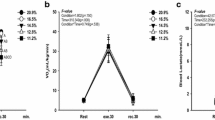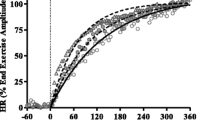Abstract
The liver is central to the metabolic response to exercise but measurements of effects of reduced liver function on the physiological adaptation to exercise are scarce. We investigated metabolic, endocrine, pulmonary and haemodynamic responses to exercise in 15 healthy untrained controls (Co) and in 30 subjects with reduced liver function (i.e. liver cirrhosis, Ci). The following protocols were used: protocol 1 maximal oxygen uptake \(\dot V{\text{O}}_{{\text{2max}}}\) and anaerobic threshold (AT), protocol 2 stepwise increases in exercise intensity from 0 to 40% \(\dot V{\text{O}}_{{\text{2max}}}\) giving steady-stage conditions, protocol 3 1 h exercise at 20% \(\dot V{\text{O}}_{{\text{2max}}}\). Muscle glycogen content was determined in 15 Ci. Spirometry was essentially normal in Ci. Result: protocol 1 Ci had impaired \(\dot V{\text{O}}_{{\text{2max}}}\) and reduced AT (P < 0.05). Basal plasma concentrations of insulin, glucagon, growth hormone and adrenaline were increased in Ci (P < 0.05); cortisol was normal. During exercise, only glucagon remained different between groups. In protocol 2 Ci had decreased resting respiratory exchange ratio (RQ: p < 0.05) associated with increased plasma concentrations of free fatty acids and glycerol. They had disproportionately enhanced lipolysis and RQ. heart rate (+ 24%), ventilation (+ 28%), thermal effects of exercise (+ 31%) and intrapulmonary shunt volume (+ 76%), which accounted for 11.7 (SD 3.0) or 7.4 (SD 0.9%) of cardiac output during exercise in Ci and Co, respectively (P < 0.05 for all the differences reported). The metabolic effects of Ci were independent of the clinical and nutritional state of the patients. In protocol 3 muscle glycogen content was highly variable in Ci, but mean values were normal [16.9 (SD 8.9) μmol·g−1 wet mass]. Glycogen content positively correlated with resting and exercise-induced RQ, but negatively correlated with the exercise-induced alterations in plasma glucose concentration. From these results we concluded that with reduced liver function \(\dot V{\text{O}}_{{\text{2max}}}\), and AT are reduced, but metabolic, pulmonary and haemodynamic reponses per unit power output are enhanced. Muscle glycogen content would seem to contribute to the metabolic response, but its mobilization to be limited in individuals with reduced liver function.
Similar content being viewed by others
References
Campbell EJM, Howell JBL (1960) Simple, rapid method of estimating arterial and mixed venous pCO2. BMJ 1:458–462
Campillo B, Fouet P, Bonnet C, Atlan G (1990a) Submaximal oxygen consumption in liver cirrhosis. Evidence of severe functional aerobic impairment, J Hepatol 10:163–167
Campillo B, Chapelain C, Bouct CJ, Frisdal E, Devanthley M, Bouisseau P, Wirquin E, Atlan G (1990b) Hormonal and metabolic changes during exercise in cirrhotic patients. Metabolism 39:18–24
DeLissio M, Goodyear LJ, Fuller S, Krawitt EL, Devlin JT (1991) Effects of treadmill exercise on fuel metabolism in hepatic cirrhosis. J Appl Physiol 70:210–215
Keller U, Sonnenberg GE, Burckhardt D, Perruchoud A (1982) Evidence for an augmented glucagon dependence of hepatic glucose production in cirrhosis of the liver. J Clin Endocrinol Metab 54:961–967
Kruzsynska Y, Williams N, Perry M, Home P (1988) The relationship between insulin sensitivity and skeletal muscle enzyme activities in liver cirrhosis. Hepatology 8:1615–1619
Lantz HU, Selberg O, Körber J, Burger M, Müller MJ (1992) Protein calorie malnutrition in liver cirrhosis. Clin Invest 70:478–486
Mö11er P, Bergström J, Fürst P, Hellström K (1984) Muscle biopsy studies in patients with moderate liver cirrhosis with special reference to energy rich phosphagens and electrolytes. Scand J Gastroenterol 19:267–272
Müller MJ, Fenk A, Lautz HU, Selberg O, Canzler H, Balks HJ, Muhlen A von zur, Schmidt E, Schmidt FW (1991) Energy expenditure and substrate metabolism in ethanol-induced liver cirrhosis. Am J Physiol 260:E338-E344
Müller MJ, Lantz HU, Plogmann B, Burger M, Körber J, Schmidt FW (1992a) Energy expenditure and substrate oxidation in patients with cirrhosis: the impact of cause, clinical staging and nutritional state. Hepatology 15:782–794
Müller MJ, Rieger A, Willmann O, Lantz HU, Balks HJ, Muhlen A von zur, Canzler H, Schmidt FW (1992b) Metabolic responses to lipid infusions in patients with liver cirrhosis. Clin Nutr 11:193–206
Müller MJ, Willmann O, Fenk A, Rieger A, Selberg O, Canzler H, Muhlen A von zur, Schmidt FW (1992c) Resting energy expenditure and the thermic effect of adrenaline in patients with liver cirrhosis. Clin Sci 83:191–198
Müller MJ, Böttcher J, Selberg O (1993) Energy expenditure and substrate metabolism in liver cirrhosis. Int J Obes 17 [Suppl 3]:S102-S106
Müller MJ, Böker KHW, Selberg O (1994a) Are patients with liver cirrhosis hypermetabolic? Clin Nutr 13:131–144
Müller MJ, Böker KHW, Selberg O (1994b) Metabolism of energy yielding substrates in patients with liver cirrhosis. Clin Invest 72:568–579
Müller MJ (1995a) Malnutrition in cirrhosis. J. Hepatol 23 [Suppl 1]:31–35
Müller MJ (1995b) Nutrition in liver disease. In: Vincent JL (ed) Yearbook in Intensive Care and Emergency Medicine. Springer, Berlin Heidelberg New York pp 789–806
Nielsen K, Kondrup J, Martinsen L, Dossing H, Stilling B (1992) Energy expenditure measured by doubly-labelled water method during hyperalimentation in malnourished patients with liver cirrhosis (abstract) Clin Nutr 11 [Suppl: 7]
Nielsen K, Kondrup J, Martinsen L, Stilling B, Wikman B (1993) Nutritional assessment and adequacy of dietary intake in hospitalised patients with alcoholic cirrhosis. Br J Nutr 69:665–679
Owen OE, Trapp VE, Reichard GA jr, Mozzoli MA, Moctezuma J, Paul P, Skutches CL, Boden G (1983) Nature and quantity of fuels consumed in patients with alcoholic cirrhosis. J Clin Invest 72:1821–1832
Petrides A, DeFronzo RA (1994) Failure of glucagon to stimulate hepatic glycogenolysis in well-nourished patients with mild cirrhosis. Metabolism 43:85–89
Plauth M, Egberts E-H, Abele R, Müller PH, Fürst P (1990) Characteristic pattern of free amino acids in plasma and skeletal muscle in stable hepatic cirrhosis. Hepatogastroenterology 37:135–139
Pugh RNH, Murray-Lyon IM, Dawson JL, Pietron MC, Will R (1973) Transsection of the oesophagus for bleeding oesophageal varices. Br J Surg 60:646–649
Romjin JA, Endert E, Sauerwein HP (1991) Glucose and fat metabolism during short-term starvation in cirrhosis. Gastroenterology 100:731–737
Roth E, Funovics I, Karner J, Mühlbacher F, Rauhs R, Steininger R, Sporn P, Kleinberger G (1984) Muscle amino acid levels in patients with liver diseases. In: Kleinberger G, Ferency P, Riederer P, Thaler H (eds) Advances in hepatic encephalopathy and urea cycle disease. Karger, Basel pp 528–537
Sherwin RS, Fisher M, Bessoff J, Snyder N, Hendler R, Conn M, Felig P (1978) Hyperglucagonemia in cirrhosis: altered secretion and sensitivity to glucagon. Gastroenterology 74:1224–1228
Thörne A, Johannson U, Wahren J, Eriksson S (1992) Thermogenic response to intravenous nutrition in patients with cirrhosis. J Hepatol 16:145–152
Wasserman JR, Cherrington AD (1991) Hepatic fuel metabolism during muscular work: role and regulation. Am J Physiol 260:E811-E824
Wasserman K, Hansen JE, Sue DY, Whipp BJ (1987) Principles of exercise testing and interpretation. Lea and Febinger, Philadelphia
Author information
Authors and Affiliations
Additional information
Dedicated to Professor D.F.W. Schmidt on the occasion of his 70th birthday
Rights and permissions
About this article
Cite this article
Müller, M.J., Dettmer, A., Tettenborn, M. et al. Metabolic, endocrine, haemodynamic and pulmonary responses to different types of exercise in individuals with normal or reduced liver function. Europ. J. Appl. Physiol. 74, 246–257 (1996). https://doi.org/10.1007/BF00377447
Accepted:
Issue Date:
DOI: https://doi.org/10.1007/BF00377447




